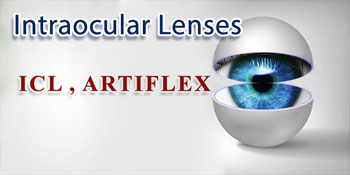Interaocular Lens Implanatation Package 660$ : The Cost of surgery withput Lenses
Intraocular lenses are lenses which are embedded with surgery inside the eye orbit permanently. These lenses are of two types:
1) those embedded during cataract surgery;
2) those incorporated as a substitute for glasses, LASIK, or PRK inside the eye orbit.
Intraocular lenses concurrent with cataract surgery
These lenses are embedded inside the eye orbit in elderly individuals or those who have cataract for any reason and require cataract surgery concurrent with this surgery and in the place of the natural lens of the eye. The reason is that during cataract surgery the natural lens of the eye is extracted which should be replaced with the artificial lens. For more information about cataract and these lenses, click here.
Intraocular lenses for correcting severe weakness of the eyes
This group of lenses are used in younger individuals who have a high degree of refractive defect of the vision (known as severe weakness of the eyes). At high numbers, typically LASIK or PRK is not a suitable option which may result in impaired vision following the operation. Therefore, at these numbers, a better and more suitable substitute is incorporation of special intraocular lenses which develop a more suitable quality of vision for these patients. These lenses have the same effects of contact lenses used by individuals, and are removed from the eyes during the night and before sleeping. The advantage of intraocular lenses in comparison to contact lenses is that intraocular lenses are permanent, and naturally there is no problem for maintaining or cleaning as well as placing and removing.
These lenses have two types. A sample of them known as ICL are embedded behind the pupil and Iris. Another group known as Artisan or Artiflex are placed in front of the pupil, which are fixed and attached to the Iris by two clamps devised in them. Each of these lenses has their own advantages and problems and one cannot consider one superior to the other. Therefore, selection of this type of lens depends on the opinion of the ophthalmologist and their experience.
These lenses are able to correct high degrees of myopia and astigmatism. However, their usage in hyperopia has some limitations. The necessary condition for putting these lenses is that the depth of the anterior chamber of the eye should be at least 3 mm, which becomes evident during imaging. For investigating and prescribing these lenses, different images should be taken from the eyes. Although these lenses have no effect on the retina and their operation does not increase the chance of incidence of retinal detachment, since in individuals with myopia the retina is very thin, before the operation, their retina is fully examined and required consultation by a retina specialist should be performed.
As with any other surgery, these lenses may also have some complications. However fortunately the complications are rare and, in most cases, treatable. These complications include inflammation and intraocular hemorrhage, intraocular infection, spontaneous dislocation of the lens or in response to trauma, cataract, and corneal turbidity. Nevertheless, it should be noted that the advantages of these lenses outweigh the risks of their complications and their long-term outcomes at high numbers is better than other operations.
Currently, in Parsian clinic, the possibility of using these lenses have been provided for patients and they are recommended by the ophthalmologist. Notes that these lenses are the latest technology of the world for correcting high refractive defects.

